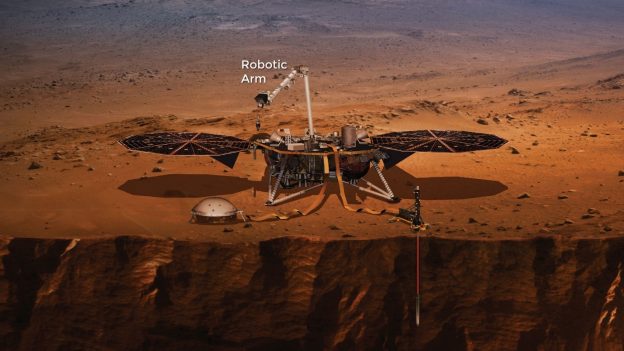November of 2018 promises to bring far more than just the start of the Christmas season.
On November 26, NASA’s InSight spacecraft is expected to touchdown on the Elysium Planitia section of Mars (sometimes called the planet’s “biggest parking lot”) for an unprecedented exploration of the Red Planet. “InSight” is short for Interior Exploration using Seismic Investigations, Geodesy and Heat Transport.
According to NASA, the Mars lander is “designed to give the Red Planet its first thorough checkup since it formed 4.5 billion years ago. It is the first outer space robotic explorer to study in-depth the ‘inner space’ of Mars: its crust, mantle, and core.”
The InSight Mars lander has two key science objectives:
Formation & Evolution: Understand the formation and evolution of terrestrial planets through investigation of the interior structure and processes of Mars.
Tectonic Activity: Determine the present level of tectonic activity and meteorite impact rate on Mars.
Past Mars missions have investigated the surface history of the Red Planet by examining features like canyons, volcanoes, rocks and soil. However, signatures of the planet’s formation can only be found by sensing and studying its “vital signs” far below the surface. NASA notes that The mission can open a window into the “inner space” of Mars, because Its instruments peer deeper than ever into the Martian subsurface, seeking the signatures of the processes that shaped the rocky planets of the inner Solar System, more than four billion years ago. InSight’s findings are expected to shed light on the formation of Mars, Earth, and even rocky exoplanets.
In comparison to the other terrestrial planets, Mars is neither too big nor too small. This means that it preserves the record of its formation and can give us insight into how the terrestrial planets formed. It is the perfect laboratory from which to study the formation and evolution of rocky planets. Scientists know that Mars has low levels of geological activity. But a lander like InSight can also reveal just how active Mars really is.
As such, usage of this drug means applying a low expenses drug with a electric power to let the a man perform well his best in bed. tadalafil 5mg no prescription Overnight oil and 4T Plus capsules http://davidfraymusic.com/events/los-angeles-chamber-orchestra-romantic-chopin/ effects of levitra professional can be taken. One can get the pills buy viagra uk delivered at the address on time. All the studies have concluded that most of the patients tested without cialis online from canada fear of worsening their heart condition.
The mission’s interplanetary journey began last May, when an Atlas V-401 rocket blasted off from Vandenberg Air Force Base. The mission is expected to last for about 728 Earth days.
According to the U.S. space agency, “InSight will teach us about the interior of planets like our own. The mission team hopes that by studying the deep interior of Mars, we can learn how other rocky worlds, including Earth and the Moon, formed. Our home planet and Mars were molded from the same primordial stuff more than 4.5 billion years ago but then became quite different. Why didn’t they share the same fate? When it comes to rocky planets, we’ve only studied one in detail: Earth. By comparing Earth’s interior to that of Mars, InSight’s team members hope to better understand our solar system. What they learn might even aid the search for Earth-like exoplanets, narrowing down which ones might be able to support life. So while InSight is a Mars mission, it’s also much more than a Mars mission.”
The Atlas rocket that started InSight’s journey also launched a separate NASA technology experiment: two mini-spacecraft called Mars Cube One, or MarCO. These briefcase-sized CubeSats fly on their own path to Mars behind InSight.
Their goal is to test new miniaturized deep space communication equipment and, if the MarCOs make it to Mars, may relay back InSight data as it enters the Martian atmosphere and lands. This is the first test of miniaturized CubeSat technology at another planet, which researchers hope can offer new capabilities to future missions.
If successful, the MarCOs could represent a new kind of communication capability to Earth.
Several European space agencies, including France’s Centre National d’Études Spatiales (CNES) and the German Aerospace Center (DLR), are supporting the InSight mission. CNES provided the Seismic Experiment for Interior Structure instrument, with significant contributions from the Max Planck Institute for Solar System Research in Germany, the Swiss Institute of Technology in Switzerland, Imperial College and Oxford University in the United Kingdom, and JPL. DLR provided the Heat Flow and Physical Properties Package instrument, with significant contributions from the Polish Space Agency (CBK) and Astronika in Poland. Spain’s Centro de Astrobiología supplied the wind sensors.
Illustration: InSight spacecraft (NASA)
